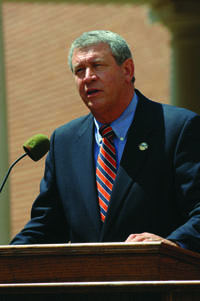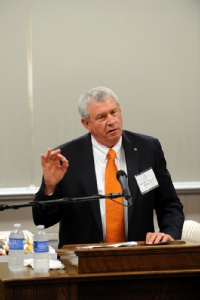Member Spotlight
Ralph Jordan, Jr.
 Jordan said he agreed to serve on the COSAM Dean's Leadership Council because it provides alums an opportunity to support the college by sharing of their expertise and resources. "Everyone should look for ways to give back to the various institutions that have supported them," Jordan said. "The COSAM Leadership Council provides just such an opportunity." Jordan was one of the strongest proponents for the construction of COSAM's new Biodiversity Learning Center, a new facility on campus that will house the university's Museum of Natural History.
Jordan said he agreed to serve on the COSAM Dean's Leadership Council because it provides alums an opportunity to support the college by sharing of their expertise and resources. "Everyone should look for ways to give back to the various institutions that have supported them," Jordan said. "The COSAM Leadership Council provides just such an opportunity." Jordan was one of the strongest proponents for the construction of COSAM's new Biodiversity Learning Center, a new facility on campus that will house the university's Museum of Natural History.
On April 19, COSAM hosted a ribbon cutting ceremony to celebrate the opening of the Biodiversity Learning Center, a new facility on campus that will house the university's Museum of Natural History (For the full story about the Biodiversity Learning Center ribbon cutting, click here. The construction of the new facility was due to the hard work of many COSAM supporters over the last several years, including faculty, administration and alumni. One of the strongest proponents for the new Biodiversity Learning Center is Ralph Jordan, Jr., who received his undergraduate degree in biological sciences in 1970 and his master's in zoology in 1975, both from Auburn University. The son of the legendary Auburn University football coach, Jordan is a life member of the Auburn Alumni Association and has served on the organization's board in a number of capacities, including as the board's president. He also served on the steering committee for Auburn's last capital campaign, and he has been a member of COSAM's Leadership Council since 1994. An Auburn native, he says he has always harbored an intense fascination for the out of doors and natural history.
"I have always enjoyed the full gamut of biodiversity – plants and plant communities, insects, fishes birds and mammals, and especially reptiles and amphibians. No one in my family ever said, 'Don't touch that!' so I was constantly getting bit or stung when I was growing up. Even in high school I kept snakes in my room and had a pet raccoon. Children are innately interested in living creatures and the natural world. What we would like to see with the museum and learning center is for it to become a place where all the people of this state and region, old and young, can go to further their knowledge and understanding of Alabama's unique natural heritage," said Jordan.
Auburn's Museum of Natural History served this exact purpose for Jordan during his high school and college years.
"The zoology faculty who were responsible for various collections within the museum were the catalyst for me, especially Dr. Robert H. Mount, Dr. George W. Folkerts and Dr. Julian Dusi," said Jordan. "When I was a senior in high school, I took it upon myself to go to Dr. Mount's house and talk to him about snakes, just after he and his family had moved in. It was immediately apparent that we shared a strong interest in natural history, and I told him I would be attending Auburn in the fall and would love the opportunity to work with him. Sometime after the start of the fall quarter, he contacted me to let me know that he had approval to hire an undergraduate student assistant to work with him in curating the reptile and amphibian collections within the museum, and maintaining and expanding the collection of living specimens. So, I worked for the entirety of my undergraduate career, curating the reptile and amphibian collections, living and preserved, in Funchess Hall."
 Thereafter, Jordan continued his work as a graduate assistant to Dr. Mount, who was working to complete his landmark book on the reptiles and amphibians of Alabama. As a part of this research, Jordan would frequently travel throughout the state in search of specimens that could be photographed for illustration purposes in the book. Because his accumulated knowledge on natural ecological communities and species distributions, Jordan's input was often sought by utilities and developers that were actively planning major construction projects, like roads, power plants or utility rights of way. Largely, these interests wanted to draw on Jordan's knowledge to ensure that planned activities could be accomplished in ways that avoided significant adverse impacts to threatened, endangered or otherwise significant species, or unique or unusual ecological communities. Because of his expertise, Jordan was eventually offered a series of contracts with the Tennessee Valley Authority and subsequently a fulltime position as TVA's nongame and endangered species biologist. Some 32 years later, Jordan retired from TVA where he had gradually assumed responsibility for natural resources management on all of TVA's public lands.
Thereafter, Jordan continued his work as a graduate assistant to Dr. Mount, who was working to complete his landmark book on the reptiles and amphibians of Alabama. As a part of this research, Jordan would frequently travel throughout the state in search of specimens that could be photographed for illustration purposes in the book. Because his accumulated knowledge on natural ecological communities and species distributions, Jordan's input was often sought by utilities and developers that were actively planning major construction projects, like roads, power plants or utility rights of way. Largely, these interests wanted to draw on Jordan's knowledge to ensure that planned activities could be accomplished in ways that avoided significant adverse impacts to threatened, endangered or otherwise significant species, or unique or unusual ecological communities. Because of his expertise, Jordan was eventually offered a series of contracts with the Tennessee Valley Authority and subsequently a fulltime position as TVA's nongame and endangered species biologist. Some 32 years later, Jordan retired from TVA where he had gradually assumed responsibility for natural resources management on all of TVA's public lands.
"Literally, Auburn laid the foundation for my career. Everything that I accomplished in my career was a byproduct of the patience and persistence of the outstanding faculty and administrators at Auburn," said Jordan. "The time I spent curating the herpetological collections within the AU Museum of Natural History paved the way for my career as a resource management and policy specialist at TVA.
"Completion of the Biodiversity Learning Center will allow the museum to greatly expand its collections; and, in time, provide significant outreach opportunities. It will be great to once again have all of the various collections housed under one roof, and in a place where they can be properly curated and studied by interested students, and more fully appreciated by the citizens of Alabama. Hopefully, they can once again serve as an inspiration for future generations of passionate young scientists like I was. We have an opportunity to excite young minds for learning, to take that flame that's burning in every third grader and keep it burning so when they come to Auburn, they will have an interest in exploring the natural history of our state, the region, and the world. And there is a tremendous need for more understanding about the natural environment and Alabama's tremendously rich biodiversity."
